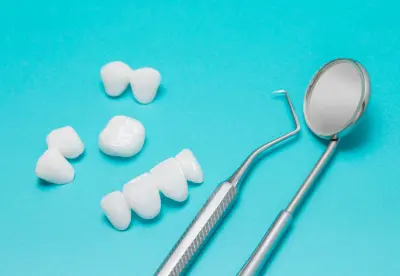

Check Out the Porcelain Veneers We Offer
We offer the following porcelain veneers at Smile By Design Dental Studios, including:
Pressed Ceramic Veneers
Pressed ceramics were first introduced to North America in the early 90s and are a popular method of creating porcelain veneers.
Wax is used to create veneer designs. The technique used for the creation of the restoration is called the lost wax technique.
The Pressing Procedure
A homogeneous ceramic ingot is heated and forced under pressure into a wax-formed void. This process will eliminate porcelain shrinkage, porosity, and inconsistencies that may be present with brush build-up techniques.
Currently, there are several types of ceramics used in the press technique. These include leucite-reinforced porcelain and lithium disilicate.
Characteristics
- Strength - there is a wide variety of pressable ceramics available, including high-strength leucite porcelain that has 160 MPa and pressed lithium disilicate, which has 400 MPA
- Fit - Excellent due to the hot press technique and homogeneous porcelain base
- Esthetics - Pressed porcelains are generally monochromatic, but the cutback technique allows for the esthetic application of finished porcelains (feldspar). Very thin pressed veneers, 0.3 mm are possible by relying on staining for esthetics.
- Lab Materials /Equipment - Many laboratories use a press ceramic 'system' routinely. Systems include shaded pressable ingots of a variety of ceramics and finishing (layering) porcelains
- Adhesion method: Veneers must be bonded
Refractory Model Veneers
This type of veneer is created using feldspathic porcelain through the original layering method.
The refractory model method of veneer fabrication was one of the original methods. It is often provided with an entire fabrication system.
Manufacturing Process
During the process, the master model is duplicated in refractory material (stone). The model then supports the porcelain during multiple firings.
Porcelain will be skillfully applied with traditional layered brush buildup techniques.
Then, using the air blasting method, the refractory model is removed. Finally, any remaining porcelain tags will be removed, and minor roughened surfaces will be finely polished.
Skilled ceramists can create very life-like restorations with internal shading and staining techniques.
Characteristics
- Strength - There is no exceptional strength in feldspathic layering porcelains.
- Esthetics - Excellent esthetics; layering techniques build tooth shade and translucence into the porcelain in layers
- Adhesion method- Traditional layering porcelains gain fracture strength from the supporting tooth structure. Veneers must also be bonded.
Platinum Foil Veneers
This is a traditional support for feldspathic porcelain build-up. The platinum foil technique for fabricating crowns has been around since the early 1900s and has several fabrication advantages.
Manufacturing Process
The manufacturing process for these veneers is quicker than other methods. The ultra-thin foil is applied to the master model and supports the layered build-up of brushed-on porcelain.
The foil supports built-up porcelains during multiple firings.
Ceramists can use the porcelains of their choice during the build-up. The thickness of the veneer can be checked during fabrication, and if a veneer is damaged during fabrication, it can be remade quickly using the same master model.
Characteristics
- Esthetics - can be excellent, as traditional layered build-up methods are used
- Tooth Prep - best when margins are clear and well defined
- Adhesion Method: Traditional layering porcelains gain fracture strength from the supporting tooth structure. Veneers must be bonded.
CAD/CAM Veneers
These veneers are a recent innovation for exceptional strength and conventional cementation. This design is manufactured using all-ceramic materials and a process aided by computers.
Manufacturing Process
Special computer software will create a 3D computer model of the involved teeth and the completed ceramic restoration design.
Guided by the original computer design, veneers can be milled out of various materials.
Milled materials may vary from standard ceramics to super-strong zirconia (rare).
Finishing porcelains complete the restoration and allow for surface characterization, staining, translucence, and other creative nuances.
This type of restoration is used in rare situations when superior strength is the main goal.
Ask About Our Veneer Products
Contact us today for more information about the veneers we offer. We hope to hear from you soon!